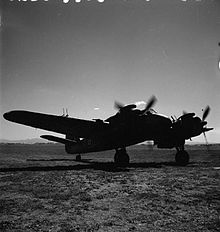Serrate radar warning receiver
Serrate one was radar warning receiver , the British night fighters in World War II , the location allowed German night fighter, the one Lichtenstein - radar used.
The devices were initially installed in night fighters of the type Bristol Beaufighter Mk. VI F of the 141st Squadron. The unit flew patrols over the night fighter bases in Germany from June 1943. In doing so, they developed the tactics for using the Serrate device. The Beaufighters flew with the stream of bombers and behaved like heavy bombers until the rear-facing Serrate warning receiver could detect the radio transmission from the Lichtenstein device of the Luftwaffe night fighter approaching from behind. The maximum range was almost 100 km. However, it was too imprecise for the target approach at short distances. The radar operator transmitted the directional information to the pilot until the fighter was approx. 2000 m away. Then the Beaufighter flew a quick turn in order to approach the German fighter from behind, to capture him with its forward-pointing radar of the type AI Mk. IV and to shoot it down. The flight maneuver and the complicated-to-use technology required specially qualified crews. In addition, it quickly became apparent that the Beaufighter was too slow and cumbersome for the task. During the first missions, in which the Serrate machines flew in the middle of the bomber stream, it turned out that the radar echoes of the bombers made it difficult to identify enemy aircraft on the display devices for AI and Serrate. In addition, since two-engine machines were generally considered hostile and fired at by the gunner of the four-engine bombers, the Serrate machines were soon only flying at the edges of the bomber stream.
In November 1943, the RAF created the 100 (Bomber Support) Group. This gave the Bomber Command a unit that could directly support the bombing attacks with ECM planes, fighter bombers and night fighters. The 141 Squadron was placed under her in December. The first use in the 100 Group took place during the air battle for Berlin on the night of December 16-17, 1943 with two Beaufighters and one two Mosquitos. A mosquito damaged a German night fighter in a dogfight. The 141 Squadron Beaufighters were quickly replaced by the more powerful Mosquito Mk-II night fighters. To accommodate the Serrate system, the four machine guns in the nose were dispensed with.
141 Squadron flew more than 1000 Serrate sorties during their subordination to 100 Group, only twelve of them with Beaufighters, all others with Mosquitos. The unit reported 70 German aircraft safely destroyed, four probably and 21 damaged for their dogfights.
The 239 Squadron, which was also subordinate to the 100 Group, also had Serrate Mosquitos. It flew almost 1,400 sorties, including an unknown number without Serrate, and reported 51 destroyed and nine allegedly destroyed or damaged enemy aircraft.
From spring 1944 the Serrate devices in the mosquitos were increasingly dispensed with, as machines with the powerful AI Mark X radar could now also be used over the continent in order to reduce the high losses of the Bomber Command. For reasons of confidentiality, the machines equipped in this way had previously only been used for the defense of the British Isles.
literature
- Martin Middlebrook / Chris Everitt: The Bomber Command War Diaries. An Operational Reference Book: 1939-1945 , Penguin, London 1990, ISBN 0-14-012936-7
- Martin Middlebrook: The Nuremberg Raid. 30-31 March 1944 . Cassell, London 2000, ISBN 0-304-35342-6
Web links
Individual evidence
- ↑ http://www.historyofwar.org/air/units/RAF/141_wwII.html
- ^ Martin Middlebrook: The Nuremberg Raid. 30-31 March 1944 . Cassell, London 2000, ISBN 0-304-35342-6 , p. 63
- ↑ https://masterbombercraig.wordpress.com/avro-lancaster-bomber/avro-lancaster-marks/safety-equipment/serrate-radar/
- ↑ http://www.lancaster-archive.com/bc_serrate.htm
- ^ Martin Middlebrook: The Nuremberg Raid. 30-31 March 1944 . Cassell, London 2000, ISBN 0-304-35342-6 , pp. 163f
- ↑ Martin Middlebrook / Chris Everitt: The Bomber Command War Diaries. An Operational Reference Book: 1939-1945 , Penguin, London 1990, ISBN 0-14-012936-7 , pp. 459f, 744
- ↑ https://masterbombercraig.wordpress.com/avro-lancaster-bomber/avro-lancaster-marks/safety-equipment/serrate-radar/
- ↑ https://masterbombercraig.wordpress.com/avro-lancaster-bomber/avro-lancaster-marks/safety-equipment/serrate-radar/
- ↑ Martin Middlebrook / Chris Everitt: The Bomber Command War Diaries. An Operational Reference Book: 1939-1945 , Penguin, London 1990, ISBN 0-14-012936-7 , p. 745
- ↑ Martin Middlebrook / Chris Everitt: The Bomber Command War Diaries. An Operational Reference Book: 1939-1945 , Penguin, London 1990, ISBN 0-14-012936-7 , p. 759
- ^ Graham White: The Long Road to the Sky. Night Fighter over Germany Pen & Sword Barnsley 2006, ISBN 978-1-84415-471-5 , pp. 81ff
- ^ Martin Middlebrook: The Nuremberg Raid. 30-31 March 1944 . Cassell, London 2000, ISBN 0-304-35342-6 , p. 289

